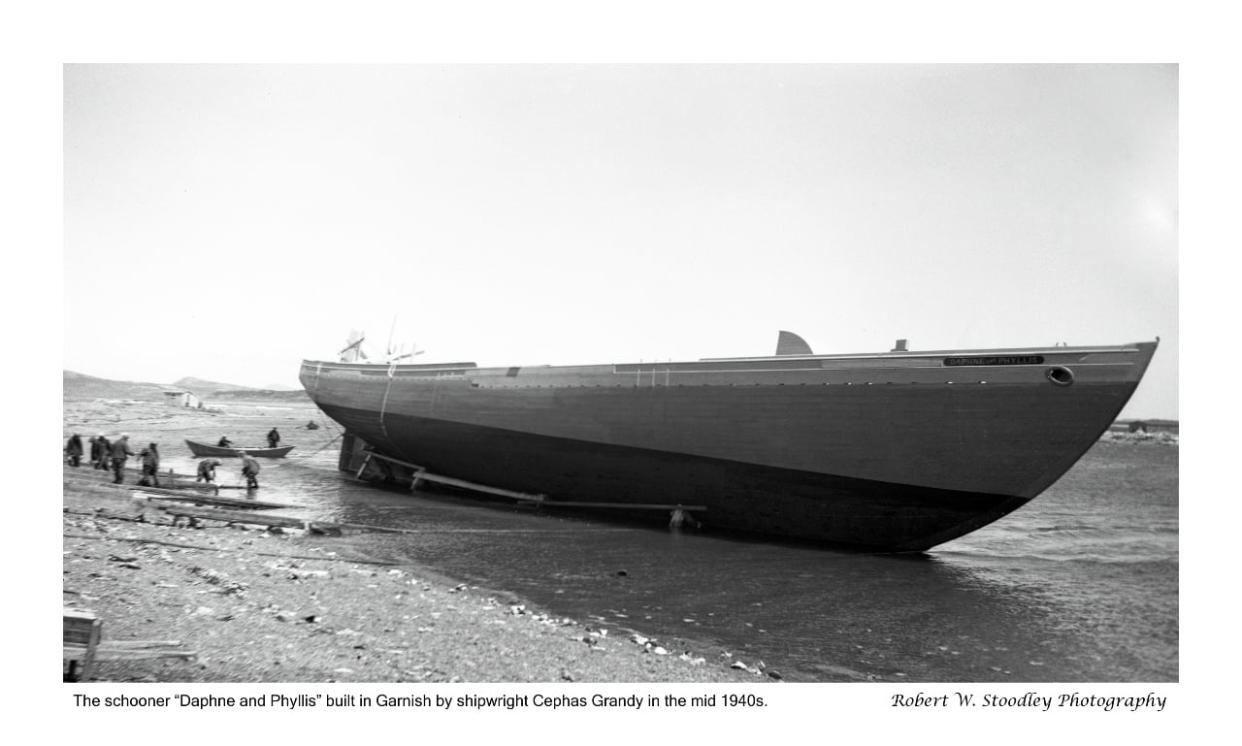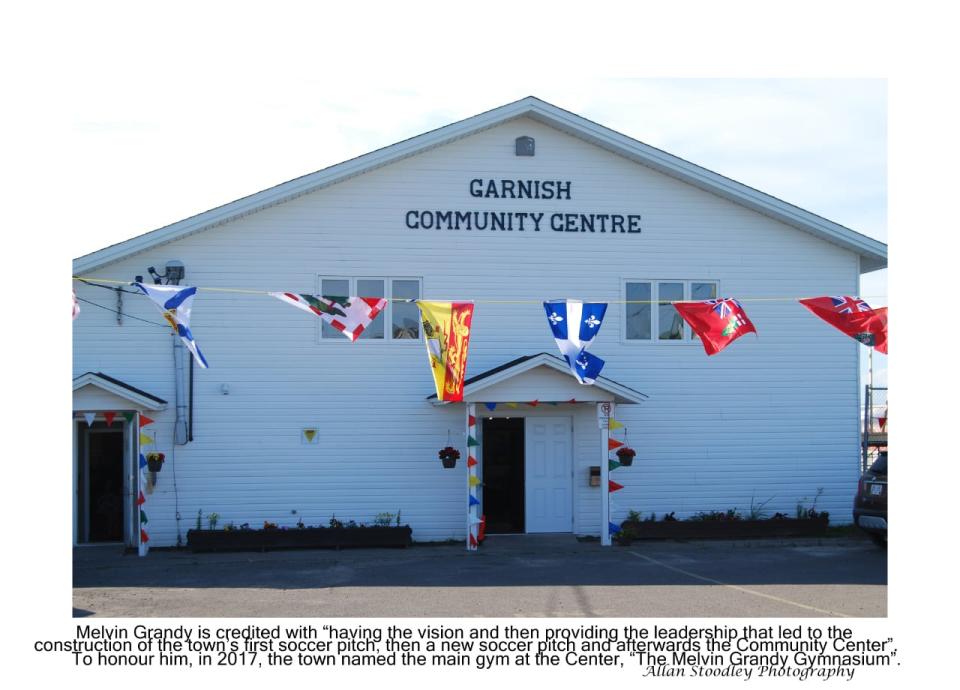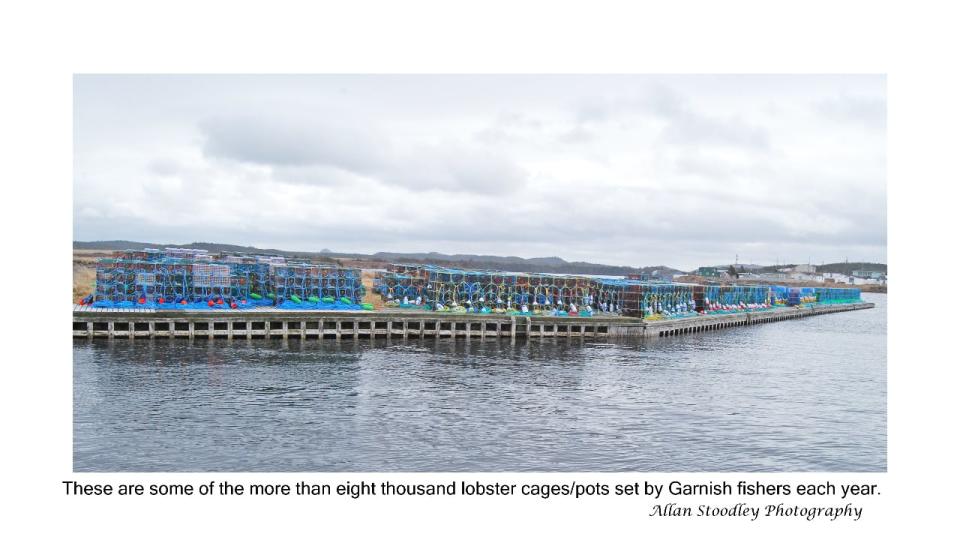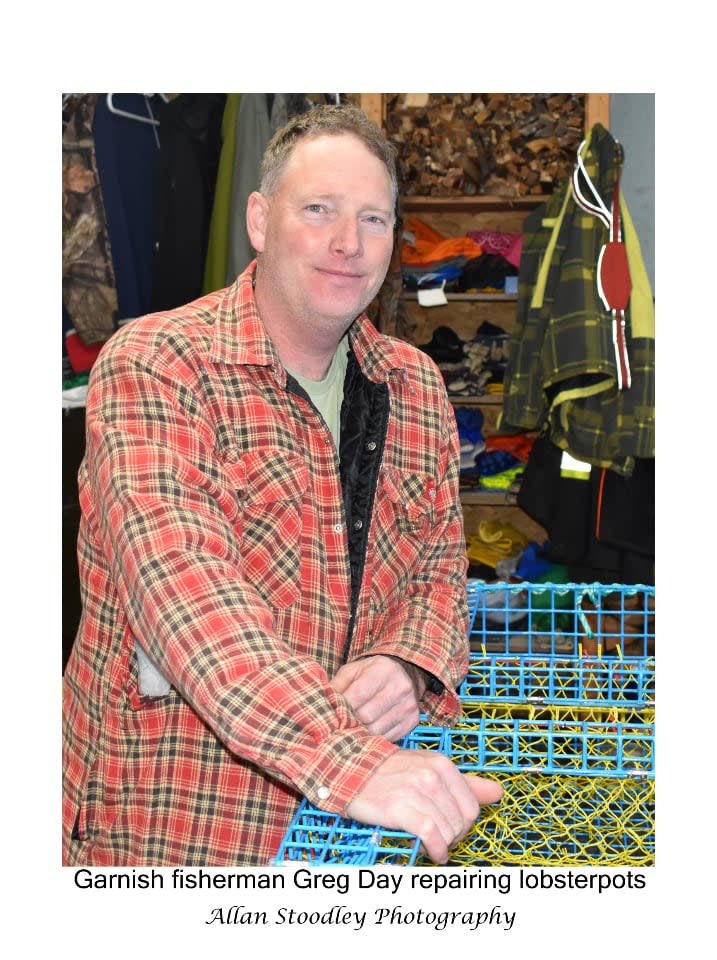The Grandys of Garnish: A history of shipbuilding and lobster fishing in a tiny N.L. town


The Daphne and Phyllis was one of several larger banking schooners built by shipwright Cephas Grandy in the mid-1940s. The vessel was side-launched — in local terminology 'launched on her bilge' — instead of the traditional way of the hull sliding down an inclined slipway, stern first. (Robert W. Stoodley Photography)
Garnish — population of 542 as of the 2021 census — can trace its history back more than two and a half centuries to 1763, when the first Grandys were unceremoniously moved from the French island of St. Pierre to the little town on Newfoundland's Burin Peninsula.
That year, after capturing the French stronghold of Quebec City and finally defeating France on the North American continent and in Newfoundland, England signed the Treaty of Paris with its old foe.
England agreed to cede the islands of St-Pierre-Miquelon to France, allowing the French to maintain a presence on this side of the Atlantic.
It meant all British subjects living in St. Pierre at that time had no choice but to leave.
According to D.W. Prowse's A History of Newfoundland, written in 1895, British soldiers took St. Pierre's British inhabitants to Newfoundland: the Hickmans were taken to Grand Bank, the Snooks to Fortune, the Cluetts to Belleoram and brothers Charles and Philip Grandy to Garnish.
The first official census in 1836 shows Garnish with a population of 76 people. A detailed census in 1857 records 127 people living there — 40 people were "catching fish" and 37 were "able-bodied seamen." The average age was relatively young, with 42 children attending school, and only one man and two women were 70 years or older.

Melvin Grandy is credited with having the vision and leadership that led to the construction of the town's first soccer pitch, then a new soccer pitch and afterward the community centre. To honour him in 2017, the town named the main gym of the community centre 'the Melvin Grandy Gymnasium. (Allan Stoodley)
In 1921, there were 746 people living in Garnish, but soon after Newfoundland joined Confederation in 1949, more than 30 homes were boarded up in the community as many people moved to the Halifax area in search of better opportunities, a move made easier now that the former dominion was a part of Canada. In the mid to late 1950s, the town did see an influx of residents when nearby Point Rosie was resettled.
During the heyday of the schooner bank fishery — from the late 1800s up to the 1940s — shipbuilding was the major employer in Garnish. Dozens of carpenters and labourers were involved, from cutting the timbers up around the headwaters of the Garnish and Black rivers to operating sawmills downstream and then the actual building of the vessels.
The industry reached its peak in the mid 1930s, when in one year, according to 97-year-old Melvin Grandy, five boats were being built at the same time.
The five vessels were different size banking schooners, capable of carrying anywhere from four dories up to 12 dories each.
Without a doubt the master boat builder in the Garnish of the 1930s and '40s was Cephas Grandy. His reputation as a craftsman spread not only all around Newfoundland but also on the Canadian mainland.
Over the years he was in charge of building several vessels for local Garnish fishermen, as well as firms in Grand Bank, Fortune, Cupids and as far away as Nova Scotia.

Melvin Grandy, pictured here in 2014, travelled to Jersey, an island in the English Channel, for his 85th birthday in search of his roots. (Allan Stoodley)
Several of the larger boats built by Grandy included the banking schooners Daphne and Phyllis, and the Jean and Mona as well as the Garnish Queen, a coaster (or freight-carrying ship).
Today, when you look at the small harbour, or barachois, at Garnish you scratch your head and wonder where the heck they built these vessels. The boat-builders of the day used the entire body of water and shoreline to their advantage.
Cephas Grandy designed a swinging bridge-ramp to span the narrow gut so carpenters could cross to the beach on the other side, where some of the ships were being built. The completed hulls could then be launched into the deep channel, which ran out toward the harbour mouth.
Other vessels were built near the harbour and some were side launched, broadside, or as per local terminology "launched on her bilge" — because, due to the type of shoreline or depth of water, the traditional stern launch could not be used.
Melvin Grandy can trace his ancestry back some six generations, to 1763, when Charles Grandy — one of the original settlers — was moved there from St. Pierre as a consequence of the Treaty of Paris.
Charles Grandy married Jane Snook. They're the great-great-great-grandparents of Melvin Grandy, a man who has been involved in everything that is Garnish all of his adult life.
He was a very successful businessman and a former town councillor but his longtime friend Horatio Cluett says his most enduring legacy lies in recreation.
"His biggest contribution to our town was his vision for the first soccer field in our community," said Cluett.
Grandy would later help spearhead a drive to build a larger soccer pitch and, soon after, the community centre.
"It was not only Melvin Grandy's vision, but under his leadership, these recreation facilities were constructed," said another friend, William Grandy. In 2017, Melvin Grandy was honoured during the Garnish Bakeapple Festival when the main gym in the community centre was named after him.

More than 8,000 lobster pots are set by Garnish fishers each year. (Allan Stoodley)
Back in 2011, Melv was looking forward to the fall of that year, when he would hopefully be celebrating his 85th birthday with his wife, Lena (née Beck) and their seven children.
During the summer, one of their daughters asked her father: "Dad, what is the one thing you haven't done that you really would like to do before you die?"
Melv pondered the question and got up from his chair. He thought about former prime minister Pierre Elliott Trudeau, who is well known for taking "a walk in the snow" when he had to make a decision about his political future.
"I'm going to take a walk in the road and think about it," he said.
He had always been interested in where the Grandys came from, as Prowse had written that the Grandys who lived in St. Pierre came from the island of Jersey in the English Channel.
After Melv's "walk in the road," the Grandy family decision was made and in honour of his upcoming 85th birthday, five of the children and their parents went back to the island of Jersey in search of their roots.
Melv, Lena and their children and family found the people of Jersey to be very friendly and helpful. Their search didn't turn up any Grandys living there today but they were shown a Grandy Will in the archives from the 1600s. They also found several names that were similar to "Grandy." Melv described it as "a trip of a lifetime."

Garnish fisherman Greg Day repairs lobster pots. (Allan Stoodley)
Today Garnish could be referred to as "the lobster fishing capital of Newfoundland," with its fishers owning some 44 licences, resulting in close to 8,000 lobster pots or cages being set each season. According to the Department of Fisheries and Oceans, there are 261 licences fished in lobster fishing area 11, which includes Fortune Bay and runs as far west as Grand Bruit.
The fishery has proven to be very lucrative in recent years, with the total landing value increasing significantly. The landed value was $104 million in 2022 and the average price per pound paid to fishers of $7.89. Just three years earlier, in 2019, the landed value was just over $65 million.
Greg Day of Garnish, age 55, has been involved in the fishery for a quarter of a century. He owns two boats: a smaller one for lobster and a larger long-liner that he uses to fish other species. He credits "V" notching of egg-bearing lobster with helping to replenish the lobster stock in this area. ("V" notching is a conservation method in which a small "V" is cut into the tail fan of egg-bearing female lobster signaling to others that it should be put back into the ocean.) He began using the technique when he started fishing.
In January, 2025, the minimum size of lobster that can be sold in the American market is due to be increased, which will also help to keep the stock healthy, according to Day. He told me "it takes seven years for a lobster to reach a marketable size".
Greg Day feels optimistic about the upcoming lobster fishery in April – he expects last year's price to hold steady and there's every indication that the local stock is healthy.
Download our free CBC News app to sign up for push alerts for CBC Newfoundland and Labrador. Click here to visit our landing page.

